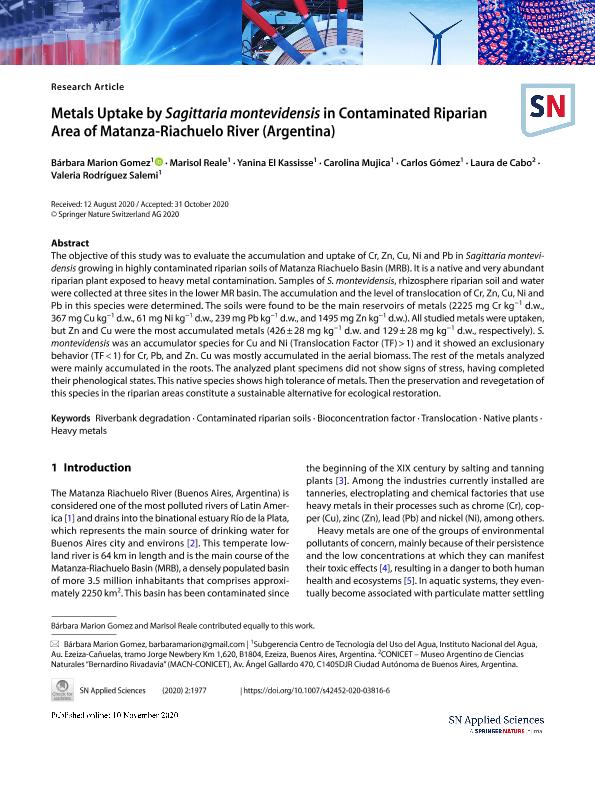Artículo
Metals uptake by Sagittaria montevidensis in contaminated riparian Area of Matanza-Riachuelo river (Argentina)
Gomez, Barbara Marion; Reale, Marisol; El Kassisse, Yanina; Mujica, Carolina; Gómez, Carlos; de Cabo, Laura Isabel ; Rodríguez Salemi, Valeria
; Rodríguez Salemi, Valeria
 ; Rodríguez Salemi, Valeria
; Rodríguez Salemi, Valeria
Fecha de publicación:
11/2020
Editorial:
Springer
Revista:
SN Applied Sciences
ISSN:
2523-3971
Idioma:
Inglés
Tipo de recurso:
Artículo publicado
Clasificación temática:
Resumen
The objective of this study was to evaluate the accumulation and uptake of Cr, Zn, Cu, Ni and Pb in Sagittaria montevidensis growing in highly contaminated riparian soils of Matanza Riachuelo Basin (MRB). It is a native and very abundant riparian plant exposed to heavy metal contamination. Samples of S. montevidensis, rhizosphere riparian soil and water were collected at three sites in the lower MR basin. The accumulation and the level of translocation of Cr, Zn, Cu, Ni and Pb in this species were determined. The soils were found to be the main reservoirs of metals (2225 mg Cr kg−1 d.w., 367 mg Cu kg−1 d.w., 61 mg Ni kg−1 d.w., 239 mg Pb kg−1 d.w., and 1495 mg Zn kg−1 d.w.). All studied metals were uptaken, but Zn and Cu were the most accumulated metals (426 ± 28 mg kg−1 d.w. and 129 ± 28 mg kg−1 d.w., respectively). S. montevidensis was an accumulator species for Cu and Ni (Translocation Factor (TF) > 1) and it showed an exclusionary behavior (TF < 1) for Cr, Pb, and Zn. Cu was mostly accumulated in the aerial biomass. The rest of the metals analyzed were mainly accumulated in the roots. The analyzed plant specimens did not show signs of stress, having completed their phenological states. This native species shows high tolerance of metals. Then the preservation and revegetation of this species in the riparian areas constitute a sustainable alternative for ecological restoration.
Archivos asociados
Licencia
Identificadores
Colecciones
Articulos(MACNBR)
Articulos de MUSEO ARG.DE CS.NAT "BERNARDINO RIVADAVIA"
Articulos de MUSEO ARG.DE CS.NAT "BERNARDINO RIVADAVIA"
Citación
Gomez, Barbara Marion; Reale, Marisol; El Kassisse, Yanina; Mujica, Carolina; Gómez, Carlos; et al.; Metals uptake by Sagittaria montevidensis in contaminated riparian Area of Matanza-Riachuelo river (Argentina); Springer; SN Applied Sciences; 2; 12; 11-2020; 1-10
Compartir
Altmétricas



